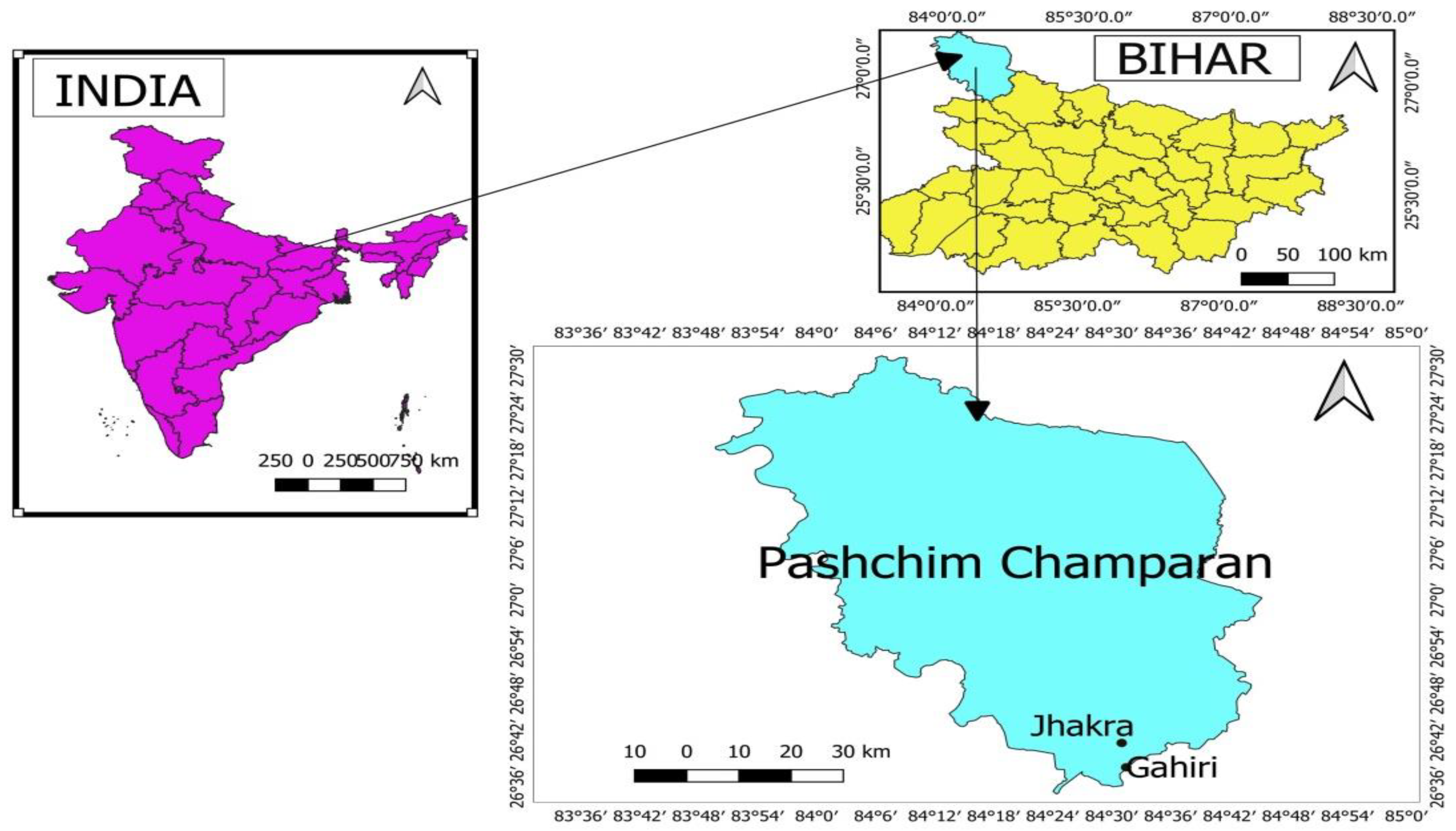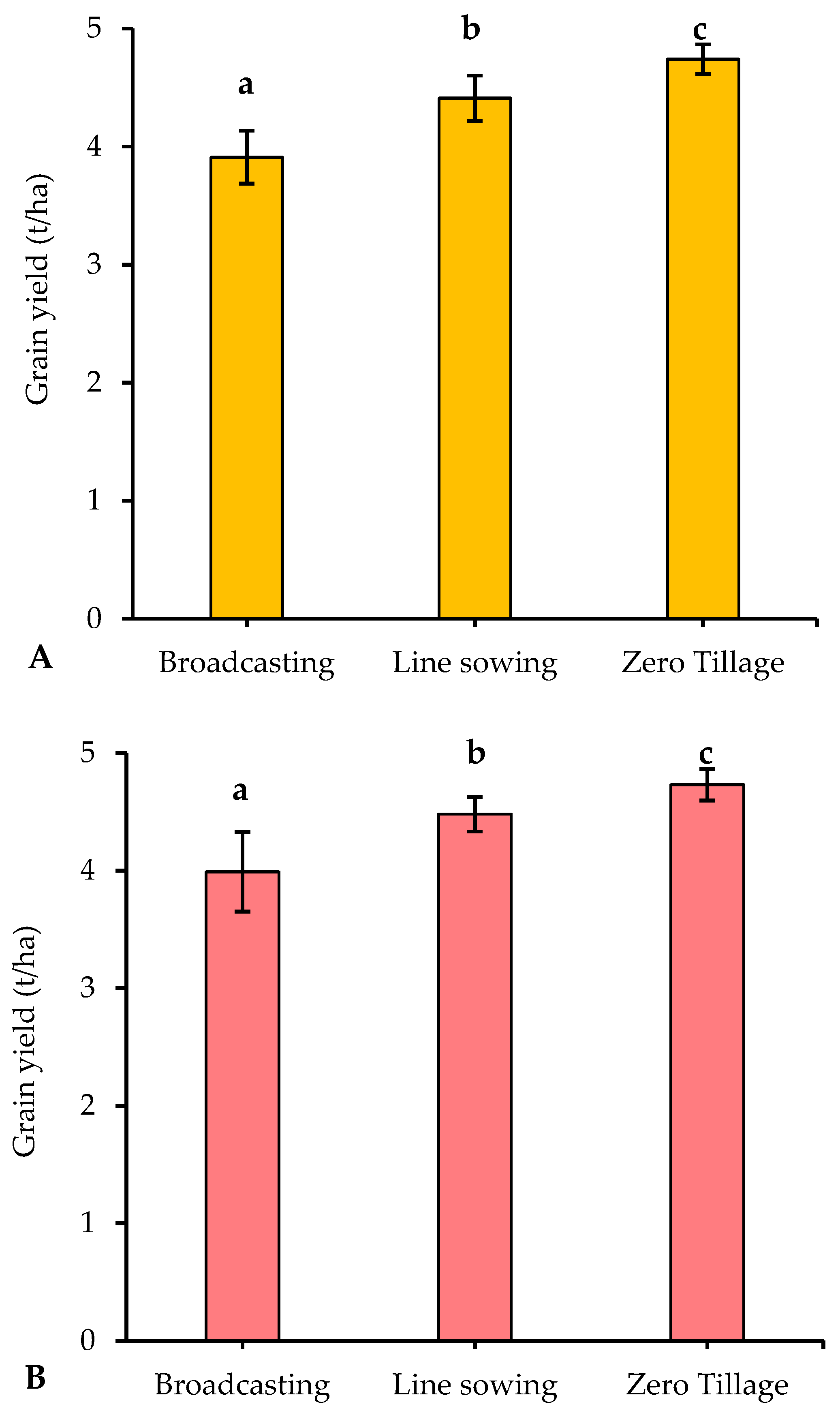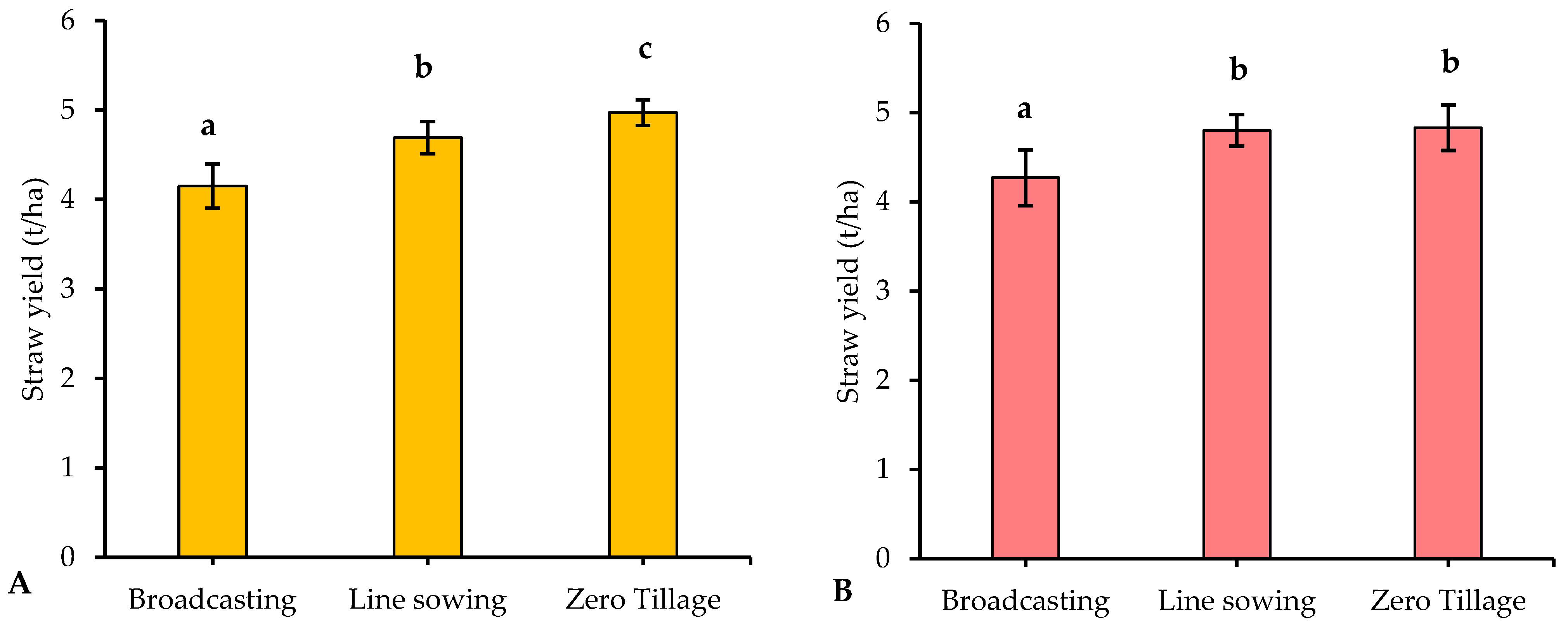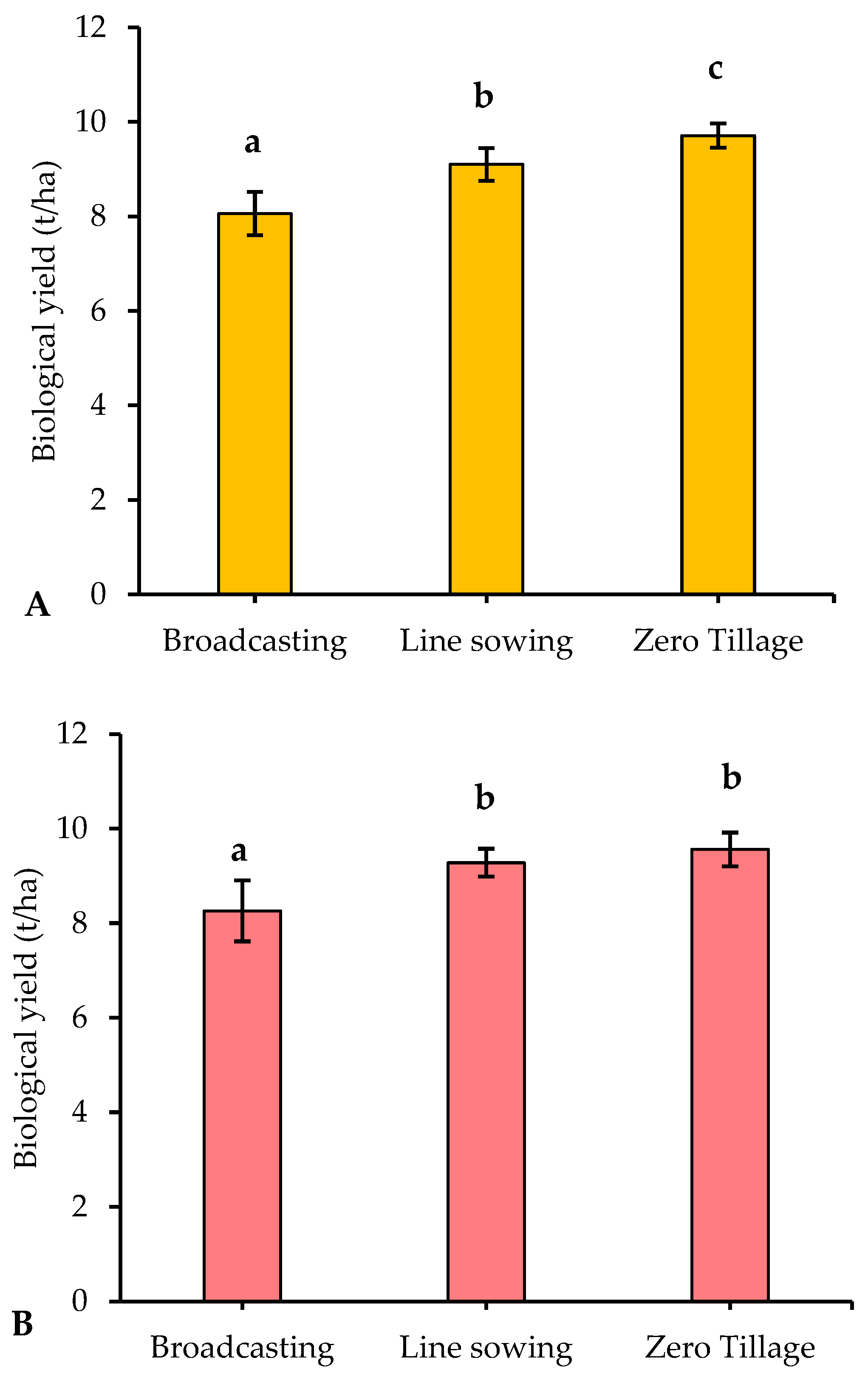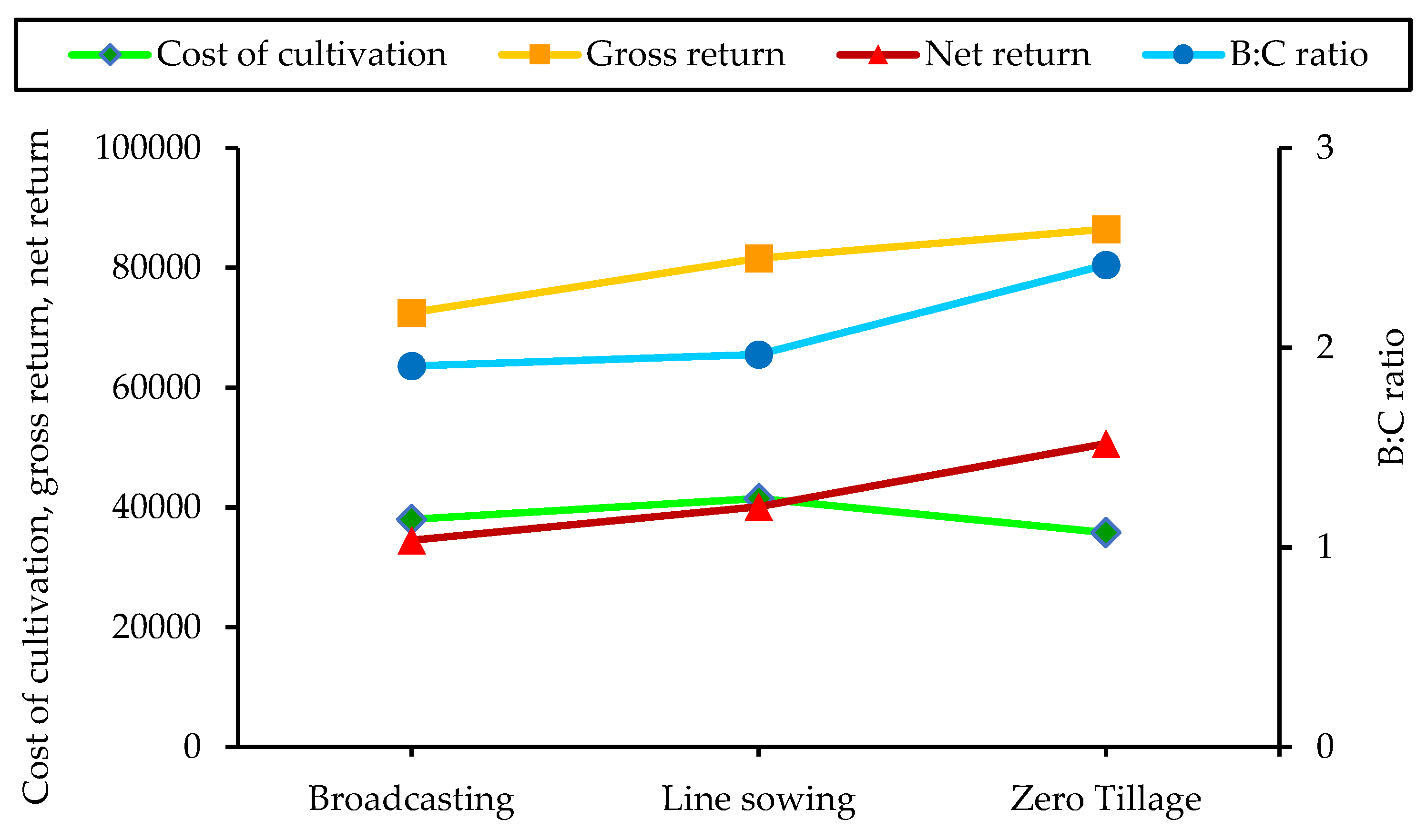1. Introduction
Climate change is affecting agriculture and the extent to which it’s affected is likely to increase further in the coming decades [
1,
2]. The changing climate makes weather anomalies more frequent, thus making crop production riskier [
3]. Small-scale and marginal farmers in India are extremely dependent on agriculture for their livelihood [
4]. Agronomic practices need to be modified or changed to make them more climate resilient. Under such circumstances, the promotion of climate-resilient production practices is the need of the hour. Rice is the major crop of India. Even though the crop is extremely important considering its dietary and economic importance, it requires a huge amount of fresh water during production [
5]. The crop also contributes to the emission of greenhouse gases, especially methane [
6]. Poor water and nutrient use efficiency in this crop has always been a scientific interest considering the vast area it covers [
7,
8]. The scarcity of good quality fresh water for irrigation, uneven or poor distribution of rainfall, the rising cost of cultivation, scarcity of labor, growing concern over climate change, etc., make it necessary to readjust rice cultivation to make it resource-efficient, cost-effective, and climate-resilient.
The traditional transplanting method of rice cultivation consumes a huge amount of water [
9]. Moreover, it is labor- and cost-intensive. The continuous anaerobic environment maintained in the paddy field results in methane emission which also contributes to global warming [
10]. Considering all these ill effects of the transplanting method of rice cultivation, an alternate method of rice cultivation where seeds are directly sown in the field is gaining popularity. In contrast to transplanted rice, direct-seeded rice provides the opportunity to save irrigation water, reduce the cost of labor, and improve the use efficiency of inputs [
11,
12]. Moreover, direct-seeded rice has also been reported to give a similar or higher yield as compared to transplanted rice [
11].
The performance of direct-seeded rice differs based on the crop establishment practice followed. Farmers practicing direct seeded rice (DSR) often sow their seeds by broadcasting, line sowing following tillage operation, or by the zero tillage method. The performance of these three practices varies and needs to be evaluated. In broadcasting, farmers sow their seeds in a tilled field, and seeds are manually sown. In the line sowing method, the paddy is sown in lines using a seeder in well-defined lines and ensuring uniform line-to-line distance. In zero tillage the paddy seeds are sown in well-defined lines, as in line sowing; however, the sowing operation is carried out in the field without tillage operations.
Although small-scale field experiments evaluating these methods are available, their performance must be evaluated in a field with a larger area to obtain a clearer picture of those practices and their feasibility. Considering the above, the present study aimed to identify three different DSR practices (broadcasting, line sowing, zero tillage) in fields in two different villages in the northwest alluvial plain zone of Bihar. The study was aimed at determining crop performance and economics. The study also aimed to find constraints in the adoption of technologies in farming through farmers’ interaction-based surveys.
2. Materials and Methods
2.1. Selection of Site and Farmers
Two villages in the West Champaran district of Bihar (i.e., Gahiri and Jhakra) were selected for this study (
Figure 1). In both the villages, a climate-resilient agriculture program is being run under Krishi Vigyan Kendra, Madhopur. Thirty farmers from each village were chosen (ten farmers for each treatment, i.e., broadcasting, line sowing, and zero tillage). Each farmer practiced a treatment in a 0.5 acre area. The soil of the fields varied from sandy loam to clay loam. The farmers’ fields were regularly monitored for collecting observation and recording data. For the purpose of the study, farmers’ fields from the same village were selected in a way so that the inter-field variability was minimal, so that the treatment effects could be observed with minimum error.
2.2. Treatments
Considering the proven climate-resilient nature of direct-seeded rice, direct seeding of rice is being promoted under the climate resilient agriculture program. However, farmers practice climate-resilient rice in three different ways.
Broadcasting: It is still a common practice among farmers. In this practice farmers sow their seed in a tilled field. Ununiform seed distribution results in improper plant stand in the field. It also makes intercultural operation difficult and the use efficiency of applied input is usually lower. A higher seed rate of around 50 kg/ha is reported by farmers.
Line sowing: In this method, field is prepared by ploughing, harrowing, and leveling, and no residue is retained. However, the seeds are sown using an inclined plate planter for direct seeding of rice in lines. This method ensures uniformity of plant stand and easier intercultural operation than broadcasting. Spacing of 20 (row to row distance) × 8 cm (plant to plant distance) is followed. Seed rate of 20 kg/ha was used for this practice.
Zero tillage: This method is similar to line sowing; however, residues are retained on the soil surface and no-tillage operation is carried out. Sowing is carried out in the residues of the previous crop without much disturbance. Spacing of 20 (row to row distance) × 8 cm (plant to plant distance) is followed. Seed rate of 20 kg/ha was followed in this method of sowing.
2.3. Crop Management
Crops were sown in the respective treatment between 21–29 June of 2022. A uniform nutrient management of 150–60–40 kg N, P2O5 and K2O per ha was applied to all the treatments. Urea, diammonium phosphate (DAP) and muriate of potash (MOP) were used as sources of nutrients. Efforts were made to provide uniform management practices in the treatments with respect to weed and water management. Fields were regularly visited (ensuring at least 2 visits in a month) and farm activities were monitored to ensure proper field management. Harvesting occurred between the 5th and 12th of November.
2.4. Observations Recorded
Plant height was taken at harvest at 5 separate points from each field (from the non-border area) and was averaged to obtain a representative plant height of the field. Tiller count from 45 to 75 days was observed at 10-day intervals for finding the maximum tiller count. In all the cases, maximum tiller count was observed at 65 days (except for 3 farmers in Jhakra practicing zero tillage and 2 fields in Gahiri practicing line sowing and zero tillage, where the maximum tillage count was observed at 55 DAS). Tiller mortality was calculated by dividing panicle numbers per m2 by the maximum tiller count per m2 and converted into percentages by multiplying by 100. At harvest stage, yield attributes of crops were observed. Five points (each point consisting of 1 m2 area) from each plot were randomly chosen (excluding border area) for collecting data on yield attributing characters. An average of 5 points were taken and data were recorded for yield attributing characters such as panicle numbers per m2, panicle length, number of panicles per m2, and number of grains per panicle. For test weight, 4 samples each consisting of 1000 grains were collected and weighed. The average value was taken as test weight. For yield parameters such as grain yield, straw yield, and biological yield, a larger area of 10 m × 10 m was chosen from each plot and harvested. The grain yield, straw yield, and biological yield were obtained and converted into t ha−1.
2.5. Economics
The cost of cultivation was calculated based on the inputs used. Gross return was calculated by multiplying grain yield with the selling price. (Minimum support price was considered as the selling price.) Net return was calculated by subtracting the cost of cultivation from gross return. The benefit–cost ratio was calculated by dividing gross return by the cost of cultivation. For economics calculation average of both villages was taken together.
2.6. Survey-Based Farmers’ Feedback
A survey was conducted for farmers (n = 50) practicing the broadcasting method of sowing to understand the reasons for not adopting line sowing or zero tillage. Similarly, a survey involving 50 farmers practicing line sowing of rice was conducted to understand the reasons for not adopting zero tillage practice.
2.7. Statistical Analysis
The significance of the mean difference was tested using a two-tailed t-test (α= 0.05) assuming two samples had equal variance. Data were analyzed using Microsoft excel 2010. Data are presented in graph form and the error bar represents the standard deviation. Treatment pair without non-significant difference has been given same alphabet while treatment pair with statistical difference has been given separate alphabet at the top of the bar in the graph.
3. Results and Discussion
3.1. Plant Height
No significant difference in plant height was observed among treatments (
Figure 2). The average plant height in both villages varied within a narrow range. Although average plant height showed an increasing trend from broadcasting to zero tillage, the difference was statistically insignificant. And although an initial variation in plant height was observed, the difference was not significant beyond 45 days. By the time of the harvest, the crops in all the establishment methods had attained similar heights (around 120 cm).
3.2. Tiller Mortality
Tiller count is one of the most important parameters that ultimately decide the yielding potential of a plant. The tiller number gradually rises from the tillering stage and reaches a maximum at the maximum tillering stage. Beyond this point, tiller senescence begins resulting in the death of tillers. Effective tillers or tillers producing panicles ultimately contribute to yield. Hence, tiller mortality can be considered as an important crop performance parameter.
Data from each village suggests a significant reduction in tiller mortality in the zero-tillage treatment (
Figure 3). Zero tillage showed tiller mortality of 19.53% and 24.67%, respectively in Gahiri and Jhakra, respectively. Tiller mortality in line sowing was found to be 24.57 and 28.52%, respectively, in Gahiri and Jhakra. The tiller mortality was highest in broadcasting (32% in Jhakra and 26% in Gahiri).
The lowest tiller mortality in zero tillage plots can be attributed to a better microclimate arising from the retention of residues on the soil surface. Residue retained on the soil surface adds organic matter and nutrients to the soil [
13]. In addition, surface residue retention results in the optimization of soil temperature [
14]. Residues retained on the soil surface reduce moisture loss through evaporation and maintain the soil’s moisture level for a longer period of time. All these benefits arising from zero tillage might contribute to lower tiller mortality in zero tillage treatment. Lower tiller mortality in no-tillage over conventional tillage has been reported by Badshah et al. [
15].
3.3. Yield Attributing Characters
A significant variation in yield attributing characters such as panicle length, number of panicles per m
2 and number of grains per panicle were observed in both villages (
Figure 4,
Figure 5 and
Figure 6). In Gahiri, the average panicle length, number of panicles per m
2, and grains per panicle were found to be 23.8 cm, 274.6, 145.4, respectively, in zero tillage treatment, while the corresponding values for broadcasting were found to be 19.9, 204.6, and 132.5, respectively. In Jhakra, the average panicle length, number of panicles per m
2, and grains per panicle were found to be 23.5 cm, 293.2, 144.6, respectively in zero tillage treatment, while the corresponding values for broadcasting were found to be 19.5 cm, 206.5, and 127.4, respectively. Intermediate results were found for line sowing in both villages. No significant difference in test weight was observed in both villages among treatments (
Figure 7).
Yield-attributing characteristics determine the ultimate yield achieved with the different establishments. Zero tillage and line sowing ensure uniform plant stands, thus ensuring better resource use efficiency. The surface residue retained in the zero tillage practice gives an additional advantage to zero tillage over line sowing, where sowing takes place after land preparation through plowing and harrowing operations. Line sowing showed better performance in terms of yield-attributing characters over line sowing because of uniform plant establishment and better resource utilization by individual plants.
The better crop performance in terms of yield-attributing characters in zero tillage might be due to better and uniform growth, suitable microclimatic conditions, and better resource utilization by the crop [
16,
17,
18]. Lower weed incidence in zero tillage also provides less crop–weed competition, thus improving crop performance [
19,
20]. Line sowing after tillage led to higher crop–weed competition over zero tillage sowing, as the weeds from lower soil depths come to the surface due to tillage [
21]. In the case of broadcasting, a ununiform plant stand not only results in poor use efficiency of input but also makes intercultural operations difficult.
3.4. Yield
Maximum yield was recorded in zero tillage followed by line sowing and broadcasting. Zero tillage resulted in a uniform plant stand and showed higher value yield-attributing parameters over broadcasting and line sowing (
Figure 8). In Gahiri, grain yield in broadcasting, line sowing, and zero tillage was found to be 39.9, 44.8, and 47.3 t/ha, respectively, while the corresponding values for Jhakhra were found to be 39.1, 44.1, and 47.4 t/ha, respectively.
The highest grain yield in zero tillage might be due to corresponding high yield attributing parameters in zero tillage. In zero tillage, the crop is sown with the residue of the previous crop, which adds organic matter and nutrients upon decomposition [
22]. The surface residue also retains soil moisture for a longer period, thus preventing moisture stress. Surface mulch provides optimum microclimate by moderating soil temperature that improves root growth and improves the soil environment altogether, providing an optimum environment for crop growth [
23,
24]. Microbial activity under zero tillage is also likely to be better considering the addition of organic matter to the soil and the resulting environment arising out of it [
24]. Line sowing showed a higher yield over broadcasting, owing to a uniform plant stand and uniform utilization of resources across the field, ensuring higher resource use efficiency.
Straw yield (
Figure 9) and biological yield (
Figure 10) also followed a similar trend as that of grain yield. Straw yield under broadcasting, line sowing, and zero tillage was found to be 41.5, 46.9, and 49.7 t/ha, respectively, in Jhakra, while the corresponding values for Gahiri were 42.7, 48, and 48.3 t/ha, respectively. The biological yield (
Figure 10) was derived from the sum of grain yield and straw yield.
3.5. Economics
The economics of crop establishment practices has a bearing on their wide-scale adaptability and acceptability among farmers. Among the practices, zero tillage showed the lowest cost of cultivation, as the cost of tillage operation was avoided. Zero tillage also ensured faster irrigation distribution and, in many places, could save one irrigation compared to the other two establishment methods. The gross return was also found to be the highest with zero tillage, considering the maximum yield achieved under this treatment (
Figure 11). Zero tillage achieved a benefit–cost ratio of 2.41, while the corresponding values for broadcasting and line sowing were found to be 1.90 and 1.97, respectively. It is important to note that the ecological benefits provided by zero tillage on soil health are often unaccounted for, which may benefit the succeeding crop in addition to the crop under cultivation.
4. Findings from Survey-Based Farmers’ Feedback
Dry, direct-seeded rice is gaining popularity among farmers, especially in villages where the climate-resilient agriculture program is being run. However, in our present study area, the farmers are practicing it in three different variants such as broadcasting, line sowing, and zero tillage. A small survey was conducted involving farmers (n = 50) practicing the broadcasting method of rice sowing. The response suggested that 70% of farmers chose this practice because of its ease of operation (no need for machinery, less time-consuming, familiarity with the practice), while 25% chose this practice because of economic constraints (cost of the machine, fuel, etc.), while remaining 5% chose this practice for other reasons (no perceived difference in the yield between line sowing and broadcasting, little machinery available with farmers, insufficient time). Our crop performance study showed that the yield of broadcasting is lower compared to the other methods. To shift the farmers from broadcasting to either the line sowing or zero tillage method, the following strategies can be implemented:
Promotion of a village-level custom hiring center and promotion of FPOs to participate in this.
Increasing awareness among farmers regarding subsidies available for the purchase of farm machinery.
Organization of frequent on-field awareness programs with a special focus on facilitating early adopter–late adopter interaction.
Similarly, a survey involving a total number of 50 farmers practicing line sowing was performed. The survey questioned the reasons for which farmers practice line sowing over zero tillage. The survey results revealed that 42% practice line sowing over zero tillage because of the perception that zero tillage invites more weed, while 40% of respondents reported a risk of higher incidence insect pest and disease infestation as a reason for not adopting zero tillage. Another 10% of the farmers found no benefit of zero tillage over line sowing in their earlier experience and hence, discontinued the practice, and 8% assigned other reasons (the stubbled field does not look visually appealing, lack of familiarity with the practice). The following strategies can be recommended to promoting zero tillage:
Capacity development program with a special focus on plant protection measures and weed management;
Facilitate interaction among farmers practicing zero tillage and line sowing;
On-farm demonstration of zero tillage technology;
Awareness of the long-term benefits of zero tillage technology.
5. Future Scope
Direct-seeded rice has multiple advantages. However, its suitability in different agro-ecological regions needs to be evaluated. The performance of DSR may vary across locations owing to differences in soil type, climate, and management practices. Site-specific adjustments may be required for better adaptation of DSR. Apart from the production and economic benefits, the environmental benefits of zero tillage technology should be recognized and adopting it should be incentivized. The establishment of custom hiring centers at a village level may also promote zero tillage technology.
6. Conclusions
Direct-seeded rice is a climate-resilient technology and has proven benefits. However, further refinement in the crop establishment is required. The full potential of direct-seeded rice can only be realized when a scientific crop-establishment strategy is followed. Zero tillage has huge potential in improving productivity, economic profitability, and enhancing resource use efficiency in the northwest alluvial plain zone of Bihar. This was evident in both study locations. Line sowing can also be recommended as an improvement over broadcasting; however, it lacks many additional benefits that zero tillage provides, especially in terms of resource saving. Even though practices such as line sowing and zero tillage have proven benefits over broadcasting, as evidenced by the data from both locations, their wide-scale adoption requires capacity building through on-farm demonstration, the availability of machinery through custom hiring centers, and policy-level interventions. Large-scale adoption of zero tillage technology can improve soil health, reduce carbon footprint, ensure food security, and provide a higher economic return for farmers. However, care must be taken to test the performance of these technology under different locations before their recommendation, as their performance may vary due to soil condition, climate, and available resources.
Author Contributions
All co-authors contributed to the conceptualization, planning, and development of the article. All co-authors substantially contributed to the article. Conceptualization: S.P., R.K.J., S.K.G., R.P.S. and A.P.; project administration: R.K.J. and A.K.S. (Anil Kumar Singh); supervision: R.K.J. and A.K.S. (Anil Kumar Singh); resources: R.K.J. and A.K.S. (Anil Kumar Singh), S.K.G., R.P.S. and M.S.K.; methodology and visualization: S.P., C.R., A.K.S. (Abhinav Kumar Singh) and A.P.; software: A.S., A.K.S. (Abhinav Kumar Singh), S.S.J. and A.P.; formal analysis: C.R., S.S.J. and A.P.; investigation: S.P., S.K.G., R.P.S. and A.K.S. (Abhinav Kumar Singh); data curation: A.S.; validation: A.K.S. (Anil Kumar Singh) and A.S.; writing—original draft preparation: S.P., A.K.S. (Abhinav Kumar Singh) and A.P.; writing—review and editing: R.K.J., A.K.S. (Anil Kumar Singh), S.K.G., R.P.S., M.S.K., A.S. and S.S.J. All authors have read and agreed to the published version of the manuscript.
Funding
This research was funded by the Government of Bihar.
Institutional Review Board Statement
Not applicable.
Informed Consent Statement
Not applicable.
Data Availability Statement
The data and materials will be made available on from the corresponding author(s) upon reasonable request.
Acknowledgments
All technical staff of KVK that supported this trial are duly acknowledged, as well as the financial support of the Climate Resilient Agriculture Program, funded by the Government of Bihar.
Conflicts of Interest
The authors declare that they have no competing interest.
References
- Kurukulasuriya, P.; Rosenthal, S. Climate Change and Agriculture: A Review of Impacts and Adaptations; World Bank: Washington, DC, USA, 2013. [Google Scholar]
- Chen, S.; Gong, B. Response and adaptation of agriculture to climate change: Evidence from China. J. Dev. Econ. 2020, 148, 102557. [Google Scholar] [CrossRef]
- Praveen, B.; Sharma, P. A review of literature on climate change and its impacts on agriculture productivity. J. Public Aff. 2019, 19, e1960. [Google Scholar] [CrossRef]
- Maitra, S.; Mondal, T.; Hossain, A.; Kalasare, R.S.; Praharaj, S.; Joy, J.M.M.; Shankar, T.; Pramanick, B.; Battaglia, M.L.; Bhattacharya, U.; et al. Impact of Climate Change on Growth and Productivity of Major Field Crops. In Response of Field Crops to Abiotic Stress; CRC Press: Boca Raton, FL, USA, 2022; pp. 217–226. [Google Scholar]
- Midya, A.; Saren, B.K.; Dey, J.K.; Maitra, S.; Praharaj, S.; Gaikwad, D.J.; Gaber, A.; Alsanie, W.F.; Hossain, A. Crop establishment methods and integrated nutrient management improve: Part i. crop performance, water productivity and profitability of rice (Oryza sativa L.) in the lower indo-gangetic plain, India. Agronomy 2021, 11, 1860. [Google Scholar] [CrossRef]
- Nan, Q.; Xin, L.; Qin, Y.; Waqas, M.; Wu, W. Exploring long-term effects of biochar on mitigating methane emissions from paddy soil: A review. Biochar 2021, 3, 125–134. [Google Scholar] [CrossRef]
- Shankar, T.; Malik, G.C.; Banerjee, M.; Dutta, S.; Praharaj, S.; Lalichetti, S.; Mohanty, S.; Bhattacharyay, D.; Maitra, S.; Gaber, A.; et al. Prediction of the Effect of Nutrients on Plant Parameters of Rice by Artificial Neural Network. Agronomy 2022, 12, 2123. [Google Scholar] [CrossRef]
- Pan, J.; Liu, Y.; Zhong, X.; Lampayan, R.M.; Singleton, G.R.; Huang, N.; Liang, K.; Peng, B.; Tian, K. Grain yield, water productivity and nitrogen use efficiency of rice under different water management and fertilizer-N inputs in South China. Agric. Water Manag. 2017, 184, 191–200. [Google Scholar] [CrossRef]
- Surendran, U.; Raja, P.; Jayakumar, M.; Subramoniam, S.R. Use of efficient water saving techniques for production of rice in India under climate change scenario: A critical review. J. Clean. Prod. 2021, 309, 127272. [Google Scholar] [CrossRef]
- Itoh, M.; Sudo, S.; Mori, S.; Saito, H.; Yoshida, T.; Shiratori, Y.; Suga, S.; Yoshikawa, N.; Suzue, Y.; Mizukami, H.; et al. Mitigation of methane emissions from paddy fields by prolonging midseason drainage. Agric. Ecosyst. Environ. 2011, 141, 359–372. [Google Scholar] [CrossRef]
- Jat, R.K.; Meena, V.S.; Kumar, M.; Jakkula, V.S.; Reddy, I.R.; Pandey, A.C. Direct Seeded Rice: Strategies to Improve Crop Resilience and Food Security under Adverse Climatic Conditions. Land 2022, 11, 382. [Google Scholar] [CrossRef]
- Liu, H.; Hussain, S.; Zheng, M.; Peng, S.; Huang, J.; Cui, K.; Nie, L. Dry direct-seeded rice as an alternative to transplanted-flooded rice in Central China. Agron. Sustain. Dev. 2015, 35, 285–294. [Google Scholar] [CrossRef]
- Gale, W.J.; Cambardella, C.A. Carbon Dynamics of Surface Residue- and Root-derived Organic Matter under Simulated No-till. Soil Sci. Soc. Am. J. 2000, 64, 190–195. [Google Scholar] [CrossRef]
- Dahiya, R.; Ingwersen, J.; Streck, T. The effect of mulching and tillage on the water and temperature regimes of a loess soil: Experimental findings and modeling. Soil Tillage Res. 2007, 96, 52–63. [Google Scholar] [CrossRef]
- Badshah, M.; Naimei, T.; Zou, Y.; Ibrahim, M.; Wang, K. Yield and tillering response of super hybrid rice Liangyoupeijiu to tillage and establishment methods. Crop. J. 2014, 2, 79–86. [Google Scholar] [CrossRef]
- Erenstein, O.; Laxmi, V. Zero tillage impacts in India’s rice–wheat systems: A review. Soil Tillage Res. 2008, 100, 1–14. [Google Scholar] [CrossRef]
- Hobbs, P.R.; Gupta, R. Problems and Challenges of No-Till Farming for the Rice-Wheat Systems of the Indo-Gangetic Plains in South. In Sustainable Agriculture and the International Rice-Wheat System; CRC Press: Boca Raton, FL, USA, 2004; pp. 123–142. [Google Scholar]
- Laxmi, V.; Erenstein, O.; Gupta, R.K.; CIMMYT. Assessing the impact of natural resource management research: The case of zero tillage in India’s rice-wheat systems. In International Research on Natural Resource Management: Advances in Impact Assessment; CABI: Wallingford, UK, 2007; pp. 68–90. [Google Scholar]
- Dang, Y.P.; Seymour, N.P.; Walker, S.R.; Bell, M.J.; Freebairn, D.M. Strategic tillage in no-till farming systems in Australia’s northern grains-growing regions: I. Drivers and implementation. Soil Tillage Res. 2015, 152, 104–114. [Google Scholar] [CrossRef]
- Derpsch, R. Conservation tillage, no-tillage and related technologies. In Conservation Agriculture; Springer: Dordrecht, The Netherlands, 2003; pp. 181–190. [Google Scholar]
- Mohler, C.L.; Frisch, J.C.; McCulloch, C.E. Vertical movement of weed seed surrogates by tillage implements and natural processes. Soil Tillage Res. 2006, 86, 110–122. [Google Scholar] [CrossRef]
- Wang, X.-B.; Cai, D.-X.; Hoogmoed, W.; Oenema, O.; Perdok, U. Potential Effect of Conservation Tillage on Sustainable Land Use: A Review of Global Long-Term Studies. Pedosphere 2006, 16, 587–595. [Google Scholar] [CrossRef]
- Stigter, K.; Ramesh, K.; Upadhyay, P.K. Mulching for microclimate modifications in farming-An overview. Indian J. Agron. 2018, 63, 89–97. [Google Scholar]
- Dumanski, J.; Peiretti, R.; Benites, J.R.; McGarry, D.; Pieri, C. The paradigm of conservation agriculture. Proc. World Assoc. Soil Water Conserv. 2006, 1, 58–64. [Google Scholar]
| Disclaimer/Publisher’s Note: The statements, opinions and data contained in all publications are solely those of the individual author(s) and contributor(s) and not of MDPI and/or the editor(s). MDPI and/or the editor(s) disclaim responsibility for any injury to people or property resulting from any ideas, methods, instructions or products referred to in the content. |
© 2023 by the authors. Licensee MDPI, Basel, Switzerland. This article is an open access article distributed under the terms and conditions of the Creative Commons Attribution (CC BY) license (https://creativecommons.org/licenses/by/4.0/).
